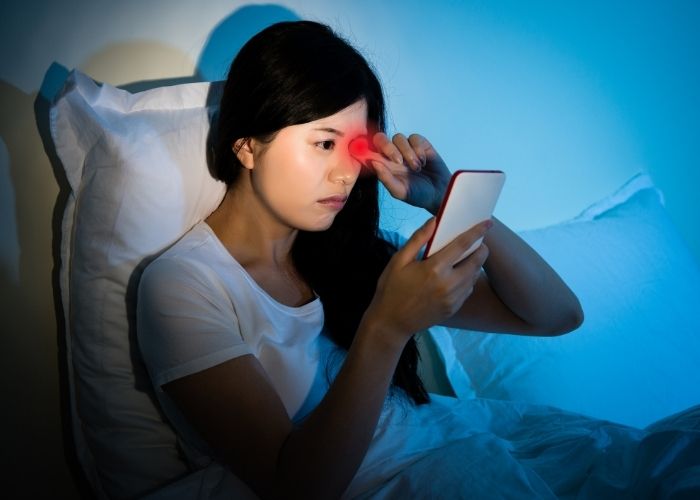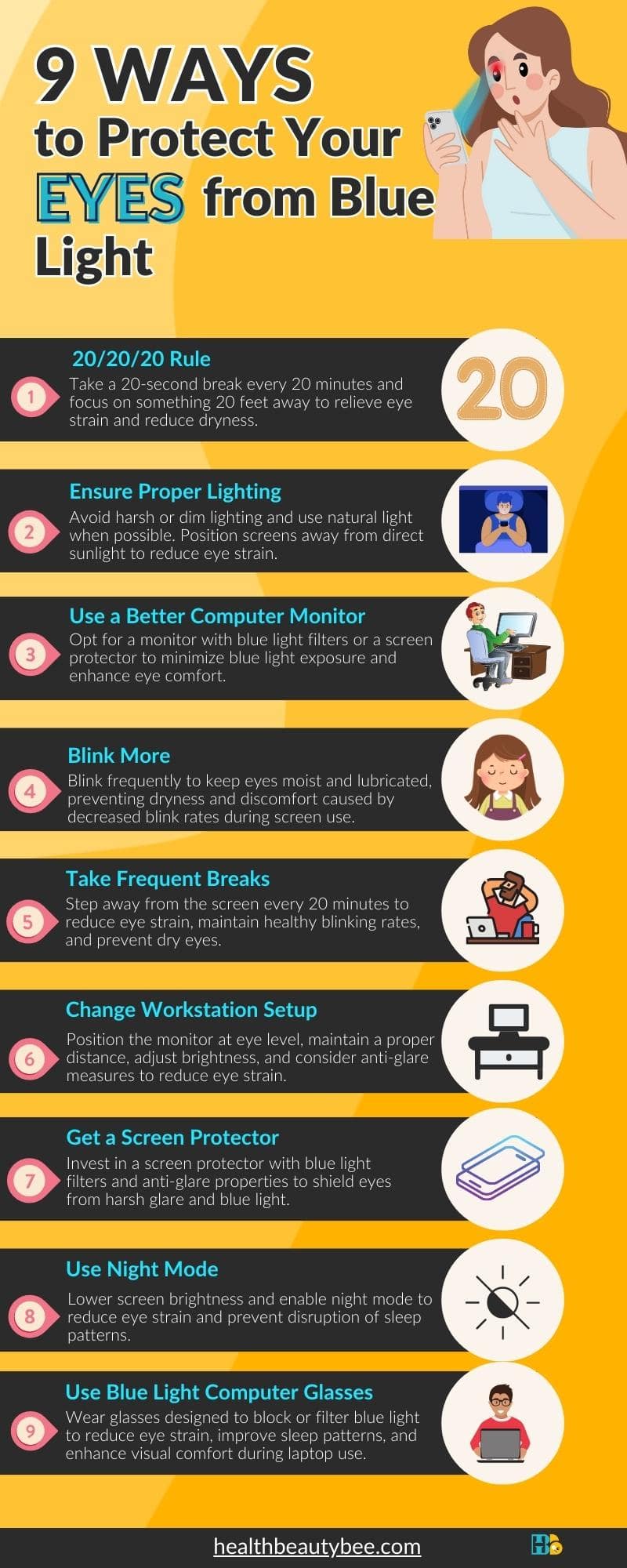In today’s digital age, spending long hours in front of a laptop screen has become inevitable. However, prolonged screen time can result in eye strain, dryness, and other vision-related issues. Therefore, it is crucial to learn how to protect your eyes from the harmful effects of laptop screens.
Are you wondering how to protect your eyes from the harmful blue light emitted by laptop or mobile screens? In this guide, we will explore the best ways to shield your eyes from the potential dangers of prolonged laptop screen usage.
Most common symptoms
According to the American Optometric Association, the most common symptoms associated with digital eye strain or computer vision syndrome (CVS) include[1]:
- Eyestrain
- Headaches
- Blurred vision
- Dry eyes
- Neck and shoulder pain
These symptoms may be caused by various factors, including
- poor lighting,
- glare on a digital screen,
- improper viewing distances,
- poor seating posture,
- uncorrected vision problems, and
- A combination of these factors
Additionally, the more time a person spends in front of digital screens, the more discomfort they may experience.
9 Best Ways to Protect Your Eyes from Blue Light
1. 20/20/20 Rule
The 20/20/20 rule is a simple yet effective way to protect your eyes from the harmful effects of prolonged laptop screen use.
It recommends that every 20 minutes, you take a 20-second break and focus your eyes on something at least 20 feet away.
This rule helps to relieve eye strain and reduce the risk of developing dry eyes caused by continuous close-up screen viewing.
By giving your eyes a short break and shifting your focus, it allows the eye muscles to relax and rehydrate. Incorporating the 20/20/20 rule into your routine is a valuable practice to help protect your eyes from laptop screen-related issues.
2. Ensure proper lighting
Proper lighting plays an essential role in protecting your eyes from mobile or laptop screens. Bright lighting and glare can cause eye strain, so it’s important to ensure that the lighting isn’t too harsh or too dim.
Use natural lighting if possible, and try to position the monitor so that it isn’t exposed to direct sunlight. Avoid using mobile or laptop screens in the dark as it can be even more damaging to the eyes.
If necessary, adjust the brightness of your screen to a comfortable level that isn’t too bright. Proper lighting can help to reduce eye strain and is an effective way to protect your eyes from mobile or laptop screen-related issues.
3. Use a better computer monitor
Using a better computer monitor can significantly help protect your eyes from laptop screen-related issues, including blue light exposure. Opt for a monitor that has built-in blue light filters or invest in a blue light filter screen protector.
These filters and protectors help reduce the amount of blue light emitted by the screen, which can cause eye strain and disrupt sleep patterns.
By using a computer monitor with proper blue light filtering capabilities, you can minimize the negative impact of blue light on your eyes and improve overall eye comfort while working or using your laptop.
4. Blink more
Blinking more frequently is a simple yet crucial practice to protect your eyes from the strain caused by laptop screens. When we focus on screens, our blink rate decreases significantly, leading to dry and irritated eyes.
By consciously reminding yourself to blink more often, you ensure that your eyes stay moist and lubricated, reducing the chances of discomfort and dryness.
Regular blinking also helps to reset your vision and prevent eye fatigue. Moreover, remember to take frequent breaks and give your eyes a chance to rest and naturally replenish their moisture throughout the day to protect your eyes from laptop screen-related issues.
5. Take breaks – a lot
Taking frequent breaks is essential to protect your eyes from the strain caused by laptop screens and blue light exposure. Prolonged exposure to screens can lead to eye fatigue, dryness, and discomfort.
By stepping away from the screen every 20 minutes and focusing on something in the distance, you give your eyes a much-needed break. This practice helps reduce eye strain, maintain healthy blinking rates, and prevent dry eyes.
Additionally, taking breaks allows your eyes to rest, minimizing the impact of blue light and promoting overall eye health while using a laptop screen.
6. Change up your workstation
Changing up your workstation setup can greatly aid in protecting your eyes from laptop screen-related issues, including the harmful effects of blue light. Position your monitor at eye level to reduce strain on your neck and eyes.
Ensure that the screen is at a distance of about an arm’s length away to prevent eye fatigue. Adjust the brightness and contrast settings to reduce glare. Consider using an anti-glare screen protector or glasses to minimize the impact of blue light.
By optimizing your workstation, you create a more eye-friendly environment that promotes comfort and reduces the risk of eye strain while using a laptop screen.
7. Get a screen protector
Investing in a quality screen protector can be an effective way to protect your eyes from the harmful effects of laptop screens and blue light.
Screen protectors come in different types and designs, including blue light filters, which reduce the amount of blue light emitted by the screen. They also offer anti-glare and scratch-resistant properties that minimize eye strain and improve visual clarity.
By using a screen protector, you add an extra layer of protection for your eyes. It shields them from the harsh glare and blue light that can cause discomfort and potentially lead to long-term eye damage.
8. Adjust screen brightness & use night mode
Adjusting the screen brightness and utilizing the night mode feature are practical ways to shield your eyes from the negative effects of laptop screens and blue light. By lowering the screen brightness to a comfortable level, you can help reduce eye strain and prevent glare.
Night mode filters out blue light, which can disrupt sleep patterns and cause eye fatigue.
By enabling this feature, the screen emits warmer colors, making it easier on the eyes, especially during late-night hours. These simple adjustments ensure a more eye-friendly screen experience, minimizing discomfort and promoting better eye health while using a laptop.
9. Get blue light computer glasses
Obtaining a pair of blue light computer glasses can significantly aid in safeguarding your eyes from the detrimental effects of laptop screens and blue light. These glasses are designed to block or filter out the blue light emitted by screens, reducing eye strain and fatigue.
By wearing blue-light computer glasses, you can alleviate the negative impact of blue light on your eyes. They can also help promote better sleep patterns and enhance visual comfort.
These glasses are a convenient and proactive solution to protect your eyes from the potential long-term consequences of excessive exposure to blue light. You can use them while using a laptop.
Infographic: How to Protect Your Eyes from Laptop and Mobile Screen Blue Light?
Save this infographic in high-quality PDF format












